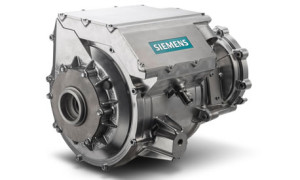
Until now, the motor and the inverter, which converts the battery’s direct current into alternating current for the motor, were two separate components.
Credit: Siemens
A team of engineers at Siemens’ has developed a way to save space, reduce weight, and cut the cost of electric car production. The team’s solution revolves around integrating an electric car’s motor and inverter, which have always been two separate components prior to this development.
This from Siemens:
The solution’s key feature is the use of a common cooling system for both components. This ensures that the inverter’s power electronics don’t get too hot despite their proximity to the electric motor, and so prevents any reduction in output or service life.
Accordingly, the weight of the vehicle is reduced due the integration of the inverter into the motor, which will now only need a single housing. Additionally, the development produces added installation space that can be used for a charging unit.
For more information on current and future developments in the electric car industry, check out some of our past coverage or head over to the Digital Library to see what our scientists are working on.

